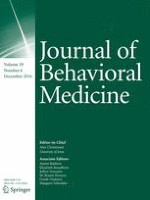11-08-2016
The Common-Sense Model of Self-Regulation (CSM): a dynamic framework for understanding illness self-management
Gepubliceerd in: Journal of Behavioral Medicine | Uitgave 6/2016
Log in om toegang te krijgenAbstract
The Common-Sense Model of Self-Regulation (the “Common-Sense Model”, CSM) is a widely used theoretical framework that explicates the processes by which patients become aware of a health threat, navigate affective responses to the threat, formulate perceptions of the threat and potential treatment actions, create action plans for addressing the threat, and integrate continuous feedback on action plan efficacy and threat-progression. A description of key aspects of the CSM’s history—over 50 years of research and theoretical development—makes clear the model’s dynamic underpinnings, characteristics, and assumptions. The current article provides this historical narrative and uses that narrative to highlight dynamic aspects of the model that are often not evaluated or utilized in contemporary CSM-based research. We provide suggestions for research advances that can more fully utilize these dynamic aspects of the CSM and have the potential to further advance the CSM’s contribution to medical practice and patients’ self-management of illness.
